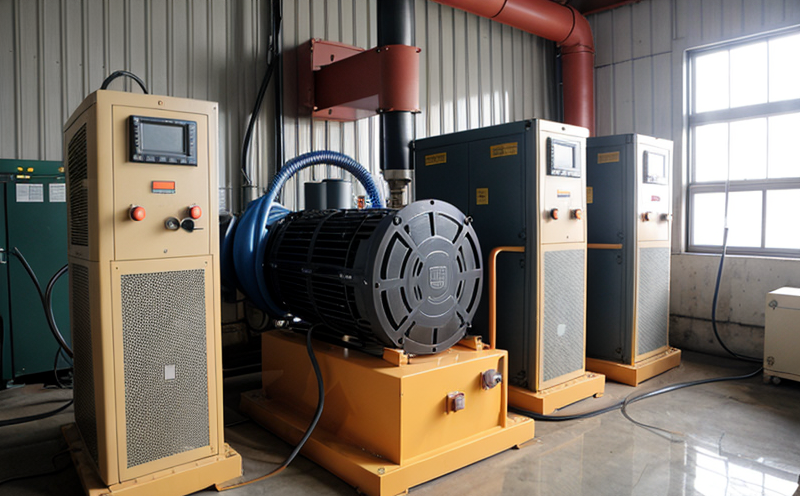ASTM G32 Cavitation Erosion Testing of Turbine Materials
The ASTM G32 standard is widely recognized in the power and utilities sector for its stringent protocols aimed at evaluating the resistance of materials to cavitation erosion. This form of wear can significantly impact the durability and lifespan of critical components, particularly turbine blades, in hydraulic systems used across power generation facilities.
Understanding cavitation erosion begins with recognizing that it occurs when areas within a flowing fluid experience rapid changes in pressure. These fluctuations generate tiny vapor bubbles, which collapse violently upon rejoining normal pressure conditions. The resulting shockwaves erode the surface of materials over time, leading to premature degradation and potential failure.
ASTM G32 specifically targets the evaluation of materials for their resistance against cavitation erosion under controlled laboratory conditions. This testing is crucial for ensuring that turbine components can withstand the harsh operational environments they are designed to operate in. By subjecting samples to simulated fluid flow and pressure variations, engineers gain insights into material performance before deployment.
The ASTM G32 protocol involves a series of steps aimed at replicating real-world conditions as closely as possible. Specimens are prepared according to the specified dimensions and tolerances outlined in the standard. These specimens are then subjected to controlled fluid flow, which includes variations in pressure, temperature, and velocity. The testing apparatus is designed to mimic the dynamics found within hydraulic turbines.
During the test, cavitation bubbles form on the surface of the specimen, leading to localized erosion. The extent and pattern of this erosion are carefully recorded using high-resolution imaging techniques. This visual data provides engineers with a clear indication of material performance under cavitation conditions. Additionally, mass loss measurements help quantify the rate of erosion.
The results from ASTM G32 testing play a pivotal role in the design and selection of materials for power generation equipment. They inform decisions regarding alloy composition, surface treatments, and component design to optimize longevity and reliability. This testing is essential not only for new product development but also for ongoing quality assurance and compliance.
The industry's reliance on ASTM G32 underscores its importance in maintaining safety standards and operational efficiency within power generation facilities. By adhering to this standard, manufacturers can ensure that their products meet the highest international benchmarks, thereby gaining competitive advantage and market acceptance.
Applied Standards
The ASTM G32 standard is one of several internationally recognized protocols used in materials testing. It aligns closely with ISO standards for similar applications but offers specific criteria tailored to the challenges posed by cavitation erosion. Additionally, EN standards provide further context within European markets.
ASTM G32 defines the methodology for evaluating the resistance of metallic materials to cavitation erosion under controlled laboratory conditions. The standard specifies the dimensions and tolerances of specimens, fluid flow parameters, test durations, and data recording techniques. Compliance with ASTM G32 ensures that testing results are consistent and comparable across different facilities.
By adhering to these standards, manufacturers can ensure that their products meet stringent quality requirements set by regulatory bodies and industry stakeholders. This consistency is vital for maintaining safety and performance benchmarks in critical applications like power generation equipment.
Eurolab Advantages
At Eurolab, we offer comprehensive ASTM G32 cavitation erosion testing services, leveraging our state-of-the-art facilities and expert technical staff to provide accurate and reliable results. Our commitment to quality is reflected in the precision of our testing apparatus and the thoroughness of our data analysis.
We pride ourselves on offering a range of services that cater to the diverse needs of the power and utilities sector, including customized test protocols when necessary. Eurolab's experienced engineers work closely with clients to ensure that all aspects of the ASTM G32 testing process are optimized for each individual project.
Our advanced testing equipment ensures that we can replicate real-world conditions as accurately as possible, providing clients with actionable insights into material performance under cavitation erosion. This level of detail is crucial for making informed decisions about component design and material selection.
In addition to ASTM G32, Eurolab offers a suite of complementary services that support the entire materials testing lifecycle. From sample preparation to final report generation, we provide a seamless experience tailored to your specific requirements. Our goal is not only to meet but exceed industry expectations through our commitment to excellence.
International Acceptance and Recognition
The ASTM G32 standard enjoys widespread acceptance across the power and utilities sector due to its rigorous testing protocols. Its international recognition is further cemented by the fact that it aligns closely with ISO standards, ensuring compatibility and interoperability between different facilities worldwide.
Many leading manufacturers of power generation equipment incorporate ASTM G32 compliance into their quality assurance processes. This standard provides a common framework for evaluating material performance under cavitation erosion conditions, facilitating consistent results across various testing environments. Compliance with ASTM G32 is often required by regulatory bodies to ensure that products meet the highest safety and operational efficiency standards.
The acceptance of ASTM G32 extends beyond just power generation facilities; it is also applicable in other sectors where cavitation erosion poses a significant challenge, such as shipbuilding and marine engineering. The standard's robust methodology ensures that materials used in these industries can withstand the harsh conditions they are exposed to.
By adhering to ASTM G32, manufacturers not only meet regulatory requirements but also enhance their reputation within the industry. The results of this testing provide a strong foundation for product development and quality assurance, contributing to the overall reliability and safety of critical components in power generation equipment.





